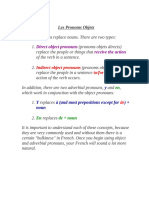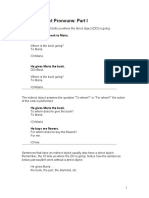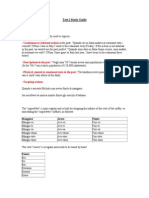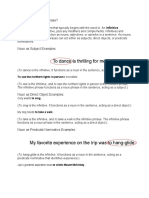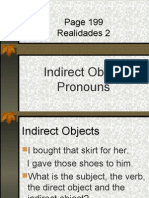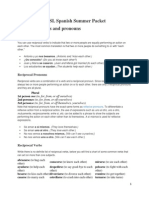Direct Pronouns: The in Italian Are
Direct Pronouns: The in Italian Are
Uploaded by
Federica MarrasCopyright:
Available Formats
Direct Pronouns: The in Italian Are
Direct Pronouns: The in Italian Are
Uploaded by
Federica MarrasOriginal Title
Copyright
Available Formats
Share this document
Did you find this document useful?
Is this content inappropriate?
Copyright:
Available Formats
Direct Pronouns: The in Italian Are
Direct Pronouns: The in Italian Are
Uploaded by
Federica MarrasCopyright:
Available Formats
DIRECT Pronouns in Italian
First of all, what’s a pronoun? A pronoun is a variable part of the language that is used to replace the noun; it indicates directly people or things that are
present in reality or that have been already mentioned, otherwise it refers to the content of whole sentences.
The direct pronouns in Italian are:
Direct pronouns
mi
ti
lo, la
ci
vi
li, le
Direct pronouns have the function of direct object. Therefore, they are used when the verb is not followed by any preposition and they answer the question
“Who? What?”.
For example:
Anna compra il libro = Anna lo compra (Anna buys the book = Anna buys it)
In this case, the direct pronoun lo replaces the direct object: “il libro”.
Let’s make another example:
Luca sogna sempre le sue cugine = Luca le sogna (Luca always dreams about his cousins = Luca always dreams about them)
In this case, the direct pronoun le replaces the direct object: “le sue cugine”.
The replacement is very easy to do, you just have to keep this in mind:
Direct pronouns (weak) Direct pronouns (strong)
mi me
ti te
lo, la lui, lei
ci noi
vi voi
li, le loro
Let’s try to replace the “strong” direct pronouns with the “weak” direct pronouns. Here you are some examples:
Mario sogna me = Mario mi sogna (Mario dreams about me)
Roberta vedrà te = Roberta ti vedrà (Roberta will see you)
Dario compra la mela (lei) = Dario la compra (Dario buys the apple = Dario buys it)
Luigi ha visto me e mio fratello (noi) = Luigi ci ha visti* (Luigi saw me and my brother = Luigi saw us)
Marta notava te e Luca (voi) = Marta vi notava (Marta noticed you and Luca = Marta noticed you)
Miriam ha venduto le case (loro) = Miriam le ha vendute* (Miriam sold the houses = Miriam sold them)
*Why “visti” instead of “visto” and “vendute” instead of “venduto” even though there is the auxiliary verb avere?
The answer is quite easy: when you put a direct pronoun before a verb in the “passato prossimo”, its past participle has to agree with gender and number
of the subject, even though you’re using the verb “avere” as an auxiliary.
For example:
– Hai comprato le mele? (Did you buy apples?)
– Sì, le ho comprate! (Yes, I bought them!)
Italians use “weak” direct pronouns a lot! In fact, you will rarely hear sentences like:
Mario sogna me
or
Luca ha visto noi
As you might have noticed, direct pronouns usually go before the verb, except in five cases, in which they are put after the verb.
First case:
1) If there are two verbs joined by a preposition:
Verrò a trovarti domani! (I’ll come see you tomorrow!)
Giungo per portarti cattive notizie. (I’m here to bring you bad news)
Passo a prenderla più tardi… (I’ll pick her up later…)
Be careful! In this case, the direct pronoun can also be put before the first verb!
For example:
Ti vengo a prendere dopo. (I’ll pick you up later)
Second case:
2) If the verb is in the imperative:
Spostalo! (Move it!)
Non tirarlo! (Don’t pull it!)
If you still have doubts and you want to study the Italian imperative more in depth, take a look at the lesson we realized about this topic!
Third case:
3) If the verb is in the gerund:
Guardandola attentamente, ho notato che stava piangendo. (Looking at her carefully, I noticed she was crying)
or
Prendendolo violentemente, si rompe. (If you take it with violence, it might break)
Fourth case:
4) If the verb is in the infinitive:
Mangiarla potrebbe farti ingrassare. (Eating it can make you gain weight)
Fifth case:
5) If there’s the adverb ECCO:
Eccola! (Here she is!)
Eccomi! (Here I am!)
Eccoti! (Here you are!)
You might also like
- TLAN 101 Grammar HandbookDocument113 pagesTLAN 101 Grammar HandbookNyurma Palmo100% (2)
- Transitive or Intransitive Verb Worksheet 2Document3 pagesTransitive or Intransitive Verb Worksheet 2Napoleon Novillero Costales80% (10)
- Week 7 - Murab Vs Mabni - HandoutDocument9 pagesWeek 7 - Murab Vs Mabni - HandoutEsio TrotNo ratings yet
- Italian Direct & Indirect Object PronounsDocument11 pagesItalian Direct & Indirect Object PronounsharunoumyNo ratings yet
- Mi Ti Gli, Le Ci VI Loro A: Problem AmbiguityDocument2 pagesMi Ti Gli, Le Ci VI Loro A: Problem AmbiguityFederica MarrasNo ratings yet
- Direct and Indirect Object Pronouns NOTESDocument18 pagesDirect and Indirect Object Pronouns NOTESTakesha WilliamsNo ratings yet
- Les Pronoms ObjetsDocument14 pagesLes Pronoms ObjetsJudy Wing-Yuen LamNo ratings yet
- Explanation of Object Pronouns in FrenchDocument3 pagesExplanation of Object Pronouns in FrenchJigar ShahNo ratings yet
- Explanation of Object Pronouns in FrenchDocument2 pagesExplanation of Object Pronouns in Frenchthyba mohamedNo ratings yet
- Double Object Pronouns in ItalianDocument4 pagesDouble Object Pronouns in ItalianharunoumyNo ratings yet
- Learn It Master Italian PronoDocument4 pagesLearn It Master Italian PronoGiuseppe FrancoNo ratings yet
- Indirect Objects and Their PronounsDocument37 pagesIndirect Objects and Their PronounsEwa KaNo ratings yet
- Present Simple and Present ContinuousDocument5 pagesPresent Simple and Present ContinuousMaria Jose SanzNo ratings yet
- Indirect Object PronounsDocument14 pagesIndirect Object Pronounsmac karlNo ratings yet
- Test 2 Study GuideDocument11 pagesTest 2 Study Guideapi-253517102No ratings yet
- Indirect Object Pronouns: Part II: He Gives The Book To MaríaDocument4 pagesIndirect Object Pronouns: Part II: He Gives The Book To Maríaamn628No ratings yet
- Direct and Indirect Object Pronouns in SpanishDocument3 pagesDirect and Indirect Object Pronouns in SpanishAdrianna starNo ratings yet
- Indirect Object Pronouns: Part I: He Gives The Book To MaríaDocument4 pagesIndirect Object Pronouns: Part I: He Gives The Book To Maríaamn628No ratings yet
- Imperativo PresenteDocument16 pagesImperativo PresenteDomy Fazzini D.No ratings yet
- Direct Indirect Double Object PronounsDocument5 pagesDirect Indirect Double Object PronounsKapil ShakyaNo ratings yet
- Direct Object Pronouns: Part I: BallDocument5 pagesDirect Object Pronouns: Part I: Ballamn628No ratings yet
- Pronouns Are Used To Replace Nouns. Pronouns Are Usually Shorter and Quicker Ways of Referring To A Noun To Help Make Sentences Less RepetitiveDocument5 pagesPronouns Are Used To Replace Nouns. Pronouns Are Usually Shorter and Quicker Ways of Referring To A Noun To Help Make Sentences Less RepetitiveAnaNo ratings yet
- Simple Present Present Progressive: Exceptions Exceptions When Adding 'S': Exceptions When Adding 'Ing'Document9 pagesSimple Present Present Progressive: Exceptions Exceptions When Adding 'S': Exceptions When Adding 'Ing'Ružica SokićNo ratings yet
- jexatujDocument2 pagesjexatujchandasindoriaNo ratings yet
- Clit IcsDocument4 pagesClit IcsMochamad Iskandarsyah Agung RamadhanNo ratings yet
- PronounsDocument19 pagesPronounstrushu1983No ratings yet
- Direct Object and Indirect Object PronounsDocument14 pagesDirect Object and Indirect Object PronounsMaría AnicetoNo ratings yet
- Flang311 Comprehensive ReviewerDocument6 pagesFlang311 Comprehensive ReviewerJiro MarianoNo ratings yet
- Les Pronoms Personnels CompletedDocument11 pagesLes Pronoms Personnels CompletedSusan FNo ratings yet
- Remedial-Inglés Conversacional IDocument9 pagesRemedial-Inglés Conversacional IVictor RojasNo ratings yet
- 2 Direct & Indirect Object PronounsDocument4 pages2 Direct & Indirect Object Pronounstr56ykpjv8No ratings yet
- Simple Present Vs Present Continuous GrammarDocument3 pagesSimple Present Vs Present Continuous Grammarluis felipe RamirezNo ratings yet
- Present Simple Sist.Document11 pagesPresent Simple Sist.Isaac Choque YucraNo ratings yet
- Introduction To VerbsDocument8 pagesIntroduction To Verbsandy_fojasNo ratings yet
- Verbs: What Is A Verb?Document41 pagesVerbs: What Is A Verb?burn100% (1)
- Teoria PronombresDocument2 pagesTeoria PronombresGu GuuNo ratings yet
- Simple PresentDocument15 pagesSimple Presentnistor mariaNo ratings yet
- What Is An Infinitive Phrase?: Phrase Includes The Infinitive, Plus Any Modifiers and Complements. Infinitives andDocument4 pagesWhat Is An Infinitive Phrase?: Phrase Includes The Infinitive, Plus Any Modifiers and Complements. Infinitives andmadeha aliNo ratings yet
- Simple Present and ContDocument9 pagesSimple Present and Contnistor mariaNo ratings yet
- Les PronomsDocument9 pagesLes PronomsTanvi NaikNo ratings yet
- Indirect Object Pronouns in SpanishDocument7 pagesIndirect Object Pronouns in Spanishc.garronNo ratings yet
- Gramatica7a1 130503211205 Phpapp01Document24 pagesGramatica7a1 130503211205 Phpapp01api-234209399No ratings yet
- Present Simple Present ContinuousDocument4 pagesPresent Simple Present ContinuousDeniseVuotoNo ratings yet
- Conteúdo 1ºs Anos 1º SemestreDocument39 pagesConteúdo 1ºs Anos 1º SemestreSandra Patrícia Miranda da SilvaNo ratings yet
- L'impératif: Moods ConditionalDocument3 pagesL'impératif: Moods ConditionalMadhur ChopraNo ratings yet
- Realidades 2: Indirect Object PronounsDocument16 pagesRealidades 2: Indirect Object Pronounsamn628No ratings yet
- Simple Present Present Continuous: Exceptions When Adding 'S': Exceptions When Adding 'Ing'Document1 pageSimple Present Present Continuous: Exceptions When Adding 'S': Exceptions When Adding 'Ing'Katerina PetrovaNo ratings yet
- 1.simple Present - Present ProgressiveDocument6 pages1.simple Present - Present ProgressiveDiana HetmachenkoNo ratings yet
- Present Simple or Present Continuous - ExplanationDocument3 pagesPresent Simple or Present Continuous - ExplanationNatalio AcerboNo ratings yet
- Notes On VerbsDocument11 pagesNotes On VerbsrazanaNo ratings yet
- Present Simple and Present ContinuousDocument3 pagesPresent Simple and Present ContinuousMel LoNo ratings yet
- Unit 1: Grammar 1. Personal PronounsDocument17 pagesUnit 1: Grammar 1. Personal PronounsannisaNo ratings yet
- Simple Present - Present Progressive: Exceptions Exceptions When Adding 'S': Exceptions When Adding 'Ing'Document3 pagesSimple Present - Present Progressive: Exceptions Exceptions When Adding 'S': Exceptions When Adding 'Ing'Diana BashinskayaNo ratings yet
- Reflexive PronounsDocument2 pagesReflexive PronounsBalcells ミレイアNo ratings yet
- Direct and Indirect Object PronounsDocument11 pagesDirect and Indirect Object PronounsHamish HaldaneNo ratings yet
- Simple Present Present ProgressiveDocument3 pagesSimple Present Present ProgressiveEvania RomanovskyNo ratings yet
- Conteúdo 1ºs Anos 2º SemestreDocument37 pagesConteúdo 1ºs Anos 2º SemestreSandra Patrícia Miranda da Silva100% (1)
- Verbs: Universitatea Valahia Facultatea de Stiinte Economice Sectia ManagementDocument6 pagesVerbs: Universitatea Valahia Facultatea de Stiinte Economice Sectia ManagementLungu NicolaeNo ratings yet
- IB SL Spanish Summer Reading PacketDocument31 pagesIB SL Spanish Summer Reading PacketAbhi SreekanthNo ratings yet
- Bahan UjianDocument9 pagesBahan UjianEmma J. GrangerNo ratings yet
- Fase 2 Ingles WritingDocument13 pagesFase 2 Ingles Writingkaterine mosqueraNo ratings yet
- Frazale VerbsDocument13 pagesFrazale VerbsmihaiconstantinescuNo ratings yet
- Italian Irregular Verbs Fully Conjugated in all Tenses (Learn Italian Verbs Book 1)From EverandItalian Irregular Verbs Fully Conjugated in all Tenses (Learn Italian Verbs Book 1)No ratings yet
- Attention: OriginDocument1 pageAttention: OriginFederica MarrasNo ratings yet
- Italian Congiuntivo - Everything You Need To Know: Third Person FormDocument1 pageItalian Congiuntivo - Everything You Need To Know: Third Person FormFederica MarrasNo ratings yet
- Taboo in IngleseDocument7 pagesTaboo in IngleseFederica MarrasNo ratings yet
- Italian Exam InstructionDocument7 pagesItalian Exam InstructionFederica MarrasNo ratings yet
- Pastel Student Planner Academic Stickers VintageGlamStudioDocument1 pagePastel Student Planner Academic Stickers VintageGlamStudioFederica MarrasNo ratings yet
- Full Download Practice Makes Perfect: Complete French All-in-One, Second Edition Annie Heminway PDF DOCXDocument57 pagesFull Download Practice Makes Perfect: Complete French All-in-One, Second Edition Annie Heminway PDF DOCXtmenhaiyazNo ratings yet
- FonologiaDocument115 pagesFonologiaIlmaNo ratings yet
- The German Professor Top 500 German Words (101-200)Document5 pagesThe German Professor Top 500 German Words (101-200)NeilNo ratings yet
- Wildman Jayne, Beddall Fiona. - Insight Upper-Intermediate Student - S Book - Libgen - LiDocument166 pagesWildman Jayne, Beddall Fiona. - Insight Upper-Intermediate Student - S Book - Libgen - LiSabina VuNo ratings yet
- Englishhawaiian DictionaryDocument268 pagesEnglishhawaiian Dictionarymarinafalaga100% (1)
- GrammerDocument2 pagesGrammerHotBros0% (1)
- Beginner FrenchDocument252 pagesBeginner FrenchAgostina MininiNo ratings yet
- Rephrasing For 2 Bach OriginalDocument20 pagesRephrasing For 2 Bach Originalmecachis91No ratings yet
- Quantifiers + Indefinite PronounsDocument3 pagesQuantifiers + Indefinite PronounsEugenia TotinhoNo ratings yet
- Voz PasivaDocument2 pagesVoz PasivaMichael AndreyNo ratings yet
- Subject Verb AgreementDocument8 pagesSubject Verb AgreementRauDeRsNo ratings yet
- English Language and Literature (Code No. 184) SYLLABUS CLASS - X (2018-19) Section Wise WeightageDocument3 pagesEnglish Language and Literature (Code No. 184) SYLLABUS CLASS - X (2018-19) Section Wise WeightageSahil KhanNo ratings yet
- ImperfectulDocument3 pagesImperfectulcoelyoungNo ratings yet
- Blooms Taxonomy Learning Objectives SampleDocument2 pagesBlooms Taxonomy Learning Objectives SampleJoy Baste SampianoNo ratings yet
- Grammar Lessons ReviewDocument14 pagesGrammar Lessons Reviewapi-451420626No ratings yet
- Noun (Nominal) Suffixes - Grammar QuizzesDocument21 pagesNoun (Nominal) Suffixes - Grammar QuizzesNikola JasikaNo ratings yet
- Eng For Law 1Document86 pagesEng For Law 1Hairus ZamanNo ratings yet
- English 1 - Infinitive and GerundDocument61 pagesEnglish 1 - Infinitive and GerundDebyNo ratings yet
- Module 14 New Idea PDFDocument15 pagesModule 14 New Idea PDFShafa Aprilia ZNo ratings yet
- The Syntax of Mi - GmaqDocument188 pagesThe Syntax of Mi - Gmaqwaymac007No ratings yet
- English Week 8Document6 pagesEnglish Week 8Ella BatilonaNo ratings yet
- VerbsDocument18 pagesVerbsAndrew NicholasNo ratings yet
- Course Paper Final PDFDocument27 pagesCourse Paper Final PDFалинаNo ratings yet
- SubjunctiveDocument17 pagesSubjunctiveKatherine RetamalNo ratings yet
- Keynote3 Unit 5 Grammar SummaryDocument1 pageKeynote3 Unit 5 Grammar SummaryAnaNo ratings yet
- Book Developingsentencesintoparagraph Erliana Nirwanto Sabarun MiftahDocument138 pagesBook Developingsentencesintoparagraph Erliana Nirwanto Sabarun MiftahJohn BhuiyanNo ratings yet
- San Rafael, Tarlac City. 1 Monthly Examination in MTB: Rafaelites Academy of Tarlac IncDocument5 pagesSan Rafael, Tarlac City. 1 Monthly Examination in MTB: Rafaelites Academy of Tarlac Incian esplanaNo ratings yet






